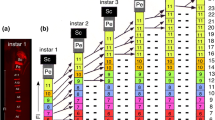Abstract
During metamorphosis of the tobacco hornworm Manduca sexta, the simple thoracic legs of the larva are remodeled into the more complex adult legs. Most of the adult leg epidermis derives from the adult primordia, small sets of epidermal cells located in specific regions of the larval leg, which proliferate rapidly in the final larval instar. In contrast, the contribution of the epidermal cells outside the primordia is unknown. In this study we have determined their contribution to the adult leg by labeling them with 5-bromodeoxyuridine (BUdR) and following their fate. Although the labeled cells diminished drastically in number, small groups of these cells persisted into the midpupal stage suggesting that they do contribute to the adult leg epidermis. We also found that during the wandering stage the adult primordia went through active proliferation and very little cell death, while the cells outside the primordia went through extensive cell death accounting for the decrease in their number. Our results indicate that two distinct cell populations exist outside the adult primordia. Most cells belong to the first population, which is larval-specific and disappears through apoptosis early in metamorphosis. The second population consists of polymorphic cells that contribute to the larval, pupal and adult leg epidermis.








Similar content being viewed by others
References
Bell RA, Joachim FA (1976) Techniques for rearing laboratory colonies of tobacco hornworms and pink bollworms. Ann Entomol Soc Am 69:365–373
Birket-Smith SJR (1984) Prolegs, legs and wings of insects. Entomonograph 5. Scandinavian Science Press, Copenhagen
Bodenstein D (1941) Investigations on the problem of metamorphosis. VIII. Studies on leg determination in insects. J Exp Zool 87:31–53
Cohen SM (1993) Imaginal disc development. In: Bate M, Martinez-Arias A (eds) The development of Drosophila. Cold Spring Harbor Press, Cold Spring Harbor, N.Y., pp 747–842
Consoulas C (2000) Remodeling of the leg sensory system during metamorphosis of the hawkmoth, Manduca sexta. J Comp Neurol 419:154–174
Consoulas C, Anezaki M, Levine RB (1997) Development of adult thoracic leg muscles during metamorphosis of the hawk moth Manduca sexta. Cell Tissue Res 287:393–412
Dohrmann CE, Nijhout HF (1988) Development of the wing margin in Precis coenia (Lepidoptera: Nymphalidae). J Res Lepid 27:151–159
Gavrieli Y, Sherman Y, Ben-Sasson SA (1992) Identification of programmed cell death in situ via specific labeling of nuclear DNA fragmentation. J Cell Biol 119:493–501
Gratzner HG (1982) Monoclonal antibody to 5-bromo- and 5-iododeoxyuridine: a new reagent for detection of DNA replication. Science 218:474–475
Huet C, Lenoir-Rousseaux JJ (1976) Etude de la mise en place de la patte imaginable de Tenebrio molitor. 1. Analyse expérimentale des processus de restauration au cours de la morphogenése. J Embryol Exp Morphol 35:303–321
Jindra M, Huang J-Y, Malone F, Asahina M, Riddiford LM (1997) Identification and mRNA developmental profiles of two ultraspiracle isoforms in the epidermis and wings of Manduca sexta. Insect Mol Biol 6:41–53
Kato Y, Nair KK, Dyer KA, Riddiford LM (1987) Changes in ploidy level of epidermal cells during last larval instar of the tobacco hornworm, Manduca sexta. Development 99:137–143
Kent KS, Levine RB (1988) Neural control of leg movements in a metamorphic insect: persistence of larval leg motor neurons to innervate the adult legs of Manduca sexta. J Comp Neurol 276:30–43
Kent KS, Fjeld CC, Anderson R (1996) Leg proprioceptors of the tobacco hornworm, Manduca sexta: organization of central projections at larval and adult stages. Microsc Res Tech 35:265–284
Kim C-W (1959) The differentiation center inducing development from larval to adult leg in Pieris brassicae (Lepidoptera). J Embryol Exp Morphol 7:572–582
Kodama R, Yoshida A, Mistui T (1995) Programmed cell death at the periphery of the pupal wing of the butterfly, Pieris rapae. Roux’s Arch Dev Biol 204:418–426
Lakes-Harlan R, Pollack GS, Merritt DJ (1991) From embryo to adult: anatomy and development of a leg sensory organ in Phormia regina, Meigen (Insecta: Diptera). II. Development and persistence of sensor neurons. J Comp Neurol 308:200–208
Miles CI, Booker RB (1993) Octopod, a homeotic mutation of the moth Manduca sexta, affects development of both mesodermal and ectodermal structures. Dev Biol 155:147–160
Riddiford LM, Curtis AT, Kiguchi K (1979) Culture of the epidermis of the tobacco hornworm Manduca sexta. TCA Manual 5:975–985
Svácha P (1992) What are and what are not imaginal discs: reevaluation of some basic concepts (Insects, Holometabola). Dev Biol 154:101–117
Taylor HM, Truman JW (1974) Metamorphosis of the abdominal ganglia of the tobacco hornworm Manduca sexta changes in populations of identified motor neurons. J Comp Physiol 90:367–388
Truman JW, Riddiford LM (1999) The origins of insect metamorphosis. Nature 410:447–452
Truman JW, Riddiford LM (2002) Endocrine insights into the evolution of metamorphosis in insects. Annu Rev Entomol 47:467–500
Weismann A (1866) Die metamorphose von Corethra plumicornis. Z Wiss Zool 16:1–83
Wheeler DE, Nijhout HF (1981) Imaginal wing discs in larvae of the soldier caste of Pheidole bicarinata vinelandica Forel (Hymenoptera: Formicidae). Int J Insect Morphol Embryol 10:131–139
Acknowledgements
We would like to thank Margrit Schubiger for suggesting the BUdR labeling experiment and Lynn Riddiford for helpful comments on the manuscript. This work was supported by NSF grant IBN-9904959 to J.W.T. and Lynn M. Riddiford.
Author information
Authors and Affiliations
Corresponding author
Additional information
Edited by D. Tautz
Rights and permissions
About this article
Cite this article
Tanaka, K., Truman, J.W. Development of the adult leg epidermis in Manduca sexta: contribution of different larval cell populations. Dev Genes Evol 215, 78–89 (2005). https://doi.org/10.1007/s00427-004-0458-5
Received:
Accepted:
Published:
Issue Date:
DOI: https://doi.org/10.1007/s00427-004-0458-5




